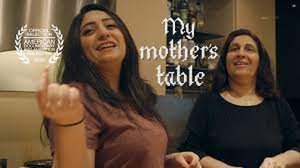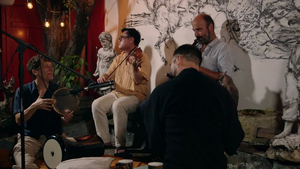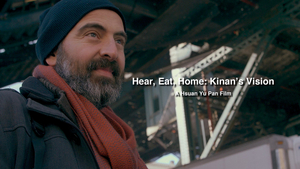Review: HEAR, EAT, HOME: KINAN'S VISION And MY MOTHER'S TABLE
Hsuan Yu Pan's compelling film making focuses on identity and communitytitled HEAR, EAT, HOME: KINAN’S VISION; the other, an eight-minute documentary, MY MOTHER’S TABLE.



Is it not so that two of the key ingredients in shaping identity, building community, and cultivating civility are food and the arts? Indeed, the habits of the heart emanate from these divine humanistic expressions.
Hsuan Yu Pan, a Taiwanese-raised, New York City-based documentarian, simply and exquisitely illustrates the point in two films ~ one, a 2:30 short, entitled HEAR, EAT, HOME: KINAN'S VISION; the other, an eight-minute documentary, MY MOTHER'S TABLE.
In 2019, the 8th anniversary, of the Syrian civil war, Pan cast her lens on Fayza Gareb and her mother Fadila Maamo, Kurdish refugees whose baggage of loss and grief is lightened by the aromatic and savory array of homeland recipes they bring to their new New York home.
MY MOTHER'S TABLE puts the spotlight on the healing power of food and the role of the kitchen as a gathering place for comity and communication. With the camaraderie of new friends comes the opportunity not only to partake of regional delicacies but also to learn more about the horrors and injustice of the strife in Syria. Offering a helping hand in this process of relocation and adjustment is Hannah Goldberg, a righteous and generous soul and the founder of Tanabel, a Brooklyn-based food and events company that provides "sustainable and empowering employment to refugee women from the Middle East" who live in the New York area.
The aftertaste of Pan's film is bittersweet. For, as much as we are immersed in the feast of senses at Fadila's table (add in Hadi and Mohamad Eldebek's evocative music), we are also painfully aware of the tragedy left behind in Syria and the cost that refugees must bear in crafting a new life.
MY MOTHER'S TABLE serves as a fitting entrée as well to Pan's more current project, HEAR, EAT, HOME: KINAN'S VISION.
If food is the engine of community in the former, music is its heartbeat in KINAN'S VISION.
Here, Pan follows clarinetist Kinan Azmeh as he muses on the topics of identity and community.
Kinan cuts a modest and humble figure as he navigates the neighborhood for which he declares "love." Pan dwells not on the fact that Azmeh, an immigrant from Syria, is an internationally celebrated virtuoso. His featured role in this film is as a messenger.
Traveling cross town New York to 125th Street in East Harlem, he joins a jam session with fellow musicians, Kaoru Watanabe on taiko (a Japanese drum) and fue (a bamboo flute), Shane Shanahan on percussion, and Fung Chem Hwei on violin. Their music is energizing and pulsating. In the background, visual artist Kevork Mourad is finishing a sweeping mural of galloping steeds. Pan has set a canvas that fittingly speaks to the harmony achievable through diversity and artistic expression.
As Kinan amplifies on his themes, he probes deep questions that arise from one whose life experiences cross multiple boundaries: How one accumulates and changes identities over time. How identity is a function of how one interacts in their current surroundings. How identity manifests itself in the way one chooses to contribute to community.
Kinan's reflections, articulated with clarity and authenticity, compel the viewer to think more deeply about roles and relations in society ~ to acknowledge that, in our life's travels, we are the sum of our experiences and our environments. In that regard, then, the matter of answering the following two questions and its implications becomes more complicated: Who are you? and Who am I?
In HEAR, EAT, HOME, Pan demonstrates again an astute eye and ear for matters of existential importance. With a keen hand at the camera, she sets a sumptuous table of ideas for our consideration and intellectual digestion.
HEAR, EAT, HOME is on the film festival circuit and is the basis for a feature film by the same name, currently in production.
Photo credit to Hsuan Yu Pan
Hsuan Yu Pan ~ https://www.panvideo.net/ ~ info.panvideo@gmail.co
Reader Reviews
Videos

